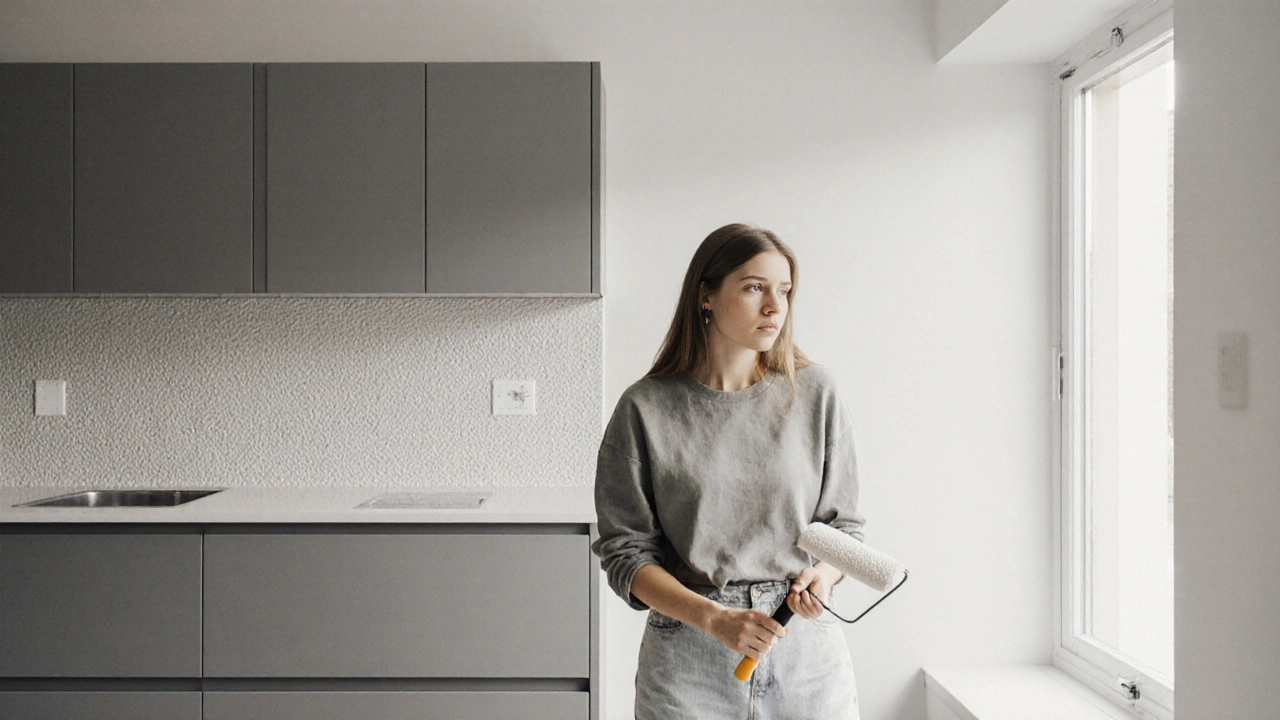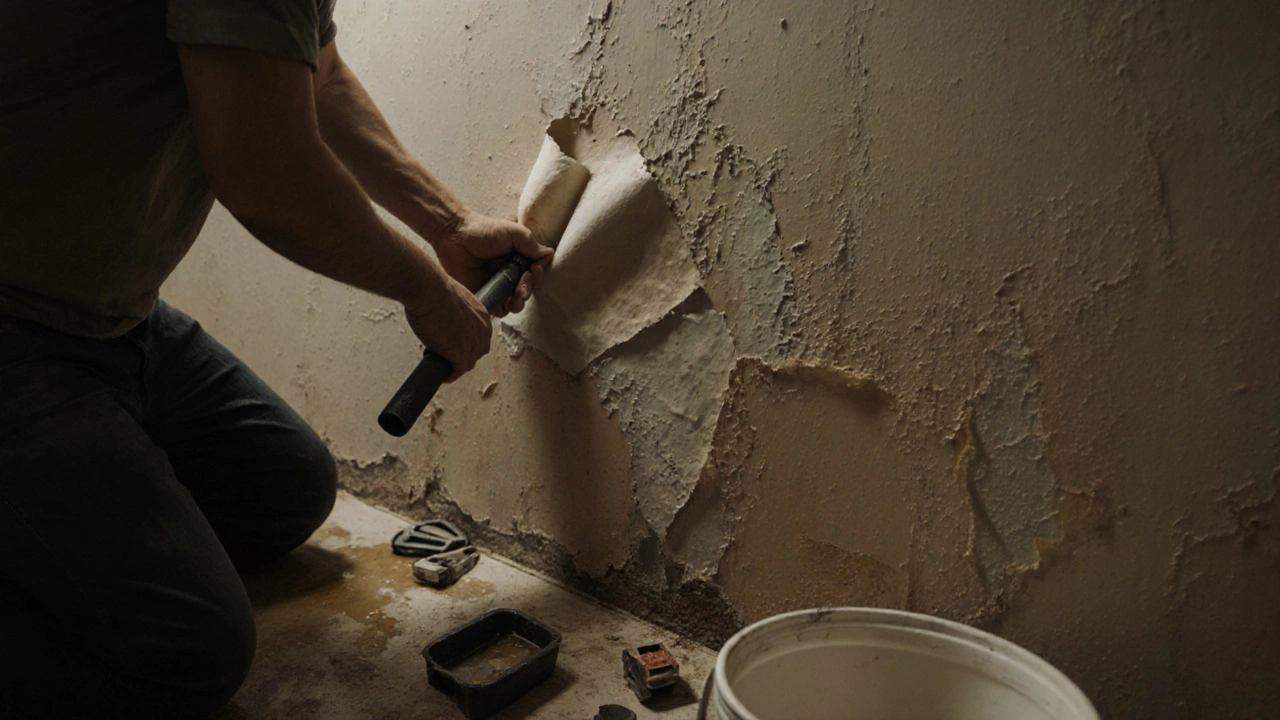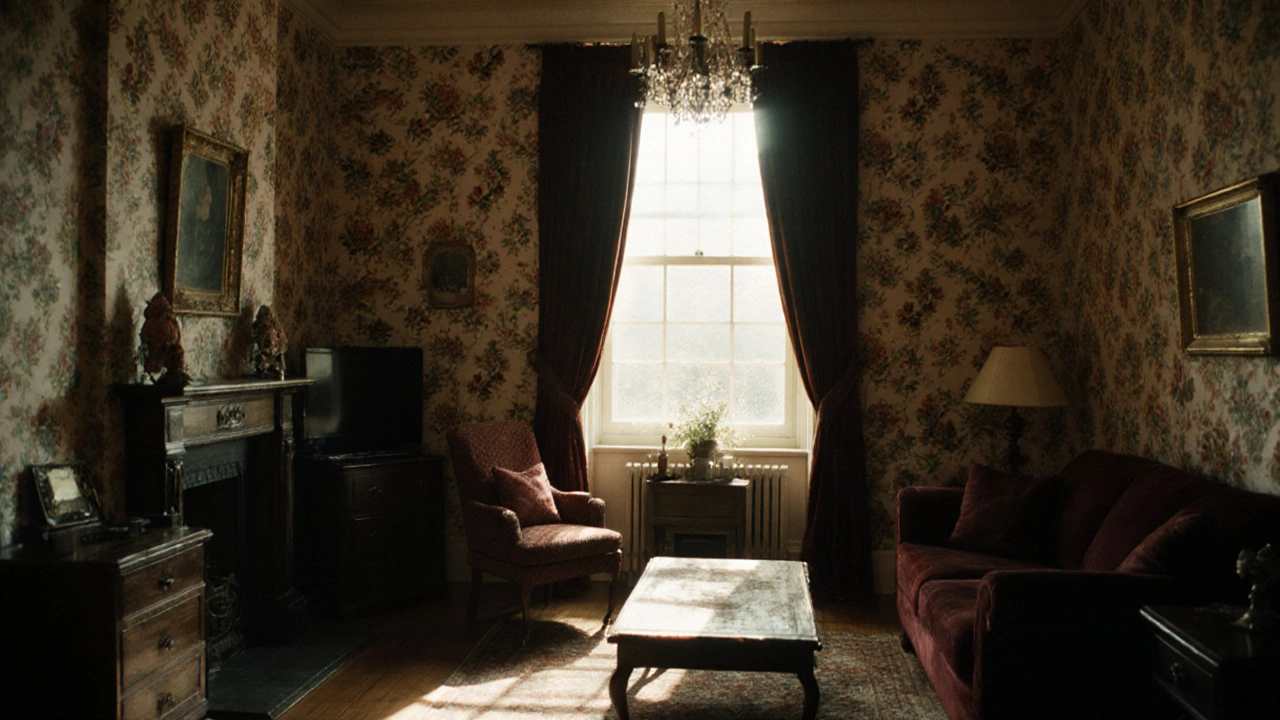Wallpaper vs Paint Cost Calculator
Estimate Your Renovation Costs
Cost Comparison Results
Paint Estimate
Total Square Feet:
Paint Cost: $
Labor Cost: $
Wallpaper Estimate
Total Square Feet:
Wallpaper Cost: $
Installation Cost: $
Key Insight from Article: 68% of homeowners in 2024 chose paint over wallpaper for main living areas (vs 42% in 2015). Paint costs $1.50-$3 per sq ft including labor, while wallpaper costs $3-$8 per sq ft for installation.
Important Note: Wallpaper removal often leaves residue and damages drywall. Real estate agents report that 71% of buyers avoid homes with wallpaper in bedrooms and bathrooms.
Why Paint Wins: With paint, you can repaint in a weekend. With wallpaper, you're stuck for years. Paint is washable, mold-resistant, and works with modern color tech like Sherwin-Williams ColorSnap.
Wallpaper used to be everywhere. In the 90s, you couldn’t walk into a new home without seeing floral patterns on the dining room walls or geometric designs in the living room. Today? You’re lucky if you see it at all. Even in high-end design magazines, wallpaper is rare. So what happened?
It got too expensive to install
Back in the day, wallpaper was cheaper than paint. But that changed. Today, a roll of good-quality wallpaper costs $50 to $120. Add professional installation, and you’re looking at $3 to $8 per square foot. Compare that to paint, which runs $1.50 to $3 per square foot including labor. For most homeowners, that’s a no-brainer. You can paint an entire room for under $200. Wallpaper? You’re easily pushing $800 to $1,500 for the same space.
And it’s not just the price. Wallpaper takes longer to hang. Paint dries in hours. Wallpaper needs time to soak, align, and dry without bubbling. One mistake - a misaligned seam, a tear, a dirty wall - and you’re starting over. Most DIYers give up after one wall.
People don’t want to commit
Wallpaper is permanent. Even the peel-and-stick kinds leave residue. Once you put it up, you’re stuck with it for years. Paint? You can repaint in a weekend. Move to a new house? You can cover it with a fresh coat before listing.
Modern lifestyles are fast. People change their minds. They want flexibility. A bold teal wall in the living room? Cool. But what if you get tired of it in two years? With paint, you just roll on gray. With wallpaper? You’re scraping, sanding, and dealing with glue residue for days.
Studies from the National Association of Home Builders show that 68% of homeowners in 2024 chose paint over wallpaper for their main living areas - up from 42% in 2015. The shift isn’t about taste. It’s about convenience.
Wallpaper looks dated
Think about the last time you saw wallpaper in a home. Was it a grandma’s house with roses and vines? A 1980s bathroom with gold swirls? That’s the image stuck in people’s heads. Even when modern wallpaper exists - minimalist textures, abstract gradients, matte finishes - most consumers don’t know it.
Designers still use it. But they’re the exception. In 2023, a survey by Houzz found that only 12% of homeowners who renovated their homes in the past year considered wallpaper. Of those, 80% chose it for an accent wall, not the whole room. And even then, they often covered it with paint within five years.
There’s also the problem of resale. Real estate agents report that 71% of buyers in 2024 said they’d avoid homes with wallpaper, especially in bedrooms and bathrooms. They assume it’s old, hard to remove, or hiding damage. Even if the wallpaper is new and high-end, buyers don’t trust it.

Paint tech got better
Paint isn’t just paint anymore. Today’s paints offer textures you can’t get with wallpaper. Matte finishes mimic linen. Metallic pigments catch light like metallic foil. Washable, scrubbable coatings last longer than vinyl. Some even have antimicrobial properties - something wallpaper can’t match.
Color technology changed too. With apps like Sherwin-Williams ColorSnap or Benjamin Moore’s Color Portfolio, you can see how a shade looks on your wall in real time. You can test dozens of colors without buying a single can. Wallpaper? You have to buy a sample roll, hang it, wait for it to dry, and hope it doesn’t fade in sunlight.
And then there’s the trend toward neutral palettes. Beige, warm gray, soft white - these dominate modern interiors. Wallpaper, even the subtlest kinds, often adds pattern or texture that clashes with this minimalist aesthetic. Paint gives you clean, flat surfaces. It’s calming. It’s predictable. It’s safe.
Wallpaper is harder to maintain
Spill coffee on a painted wall? Wipe it. Spill it on wallpaper? You’re praying it’s washable. Most residential wallpaper isn’t. Even the ones labeled “washable” can fade, peel, or bubble if you rub too hard.
Humidity is another killer. Bathrooms and kitchens are death zones for wallpaper. Moisture gets behind the paper, and mold grows. Paint? It’s designed to handle steam. You can even buy mold-resistant paint for bathrooms. Wallpaper? You’re asking for trouble.
And what about pets? Dogs scratch. Kids draw. Cats climb. A torn wallpaper seam is a nightmare to fix. A paint scratch? Touch-up paint from the can you kept under the sink. Done in five minutes.

It’s not gone - it’s just niche
Wallpaper isn’t dead. It’s just not for everyone anymore. You still see it in luxury hotels, boutique restaurants, and high-end showrooms. Designers use it for feature walls in media rooms or as a backdrop for art. But in homes? It’s rare.
There’s a small but growing group of people who love it. Millennials who grew up with it in their grandparents’ homes are bringing it back - but selectively. They’re choosing non-woven, breathable papers that don’t trap moisture. They’re using digital printing for custom designs - their own photos, abstract art, even QR codes that link to playlists.
But these are exceptions. The mass market moved on. Wallpaper became too costly, too risky, and too hard to live with. Paint won because it’s easier, cheaper, and more forgiving. It’s the default now. And in home design, default means safe. Safe means popular.
When might wallpaper come back?
It could. If wallpaper manufacturers start making affordable, peelable, washable, mold-resistant versions that install like decals, it might. If smart homes start integrating wallpaper with LED lighting or sound-dampening tech, it could become a feature again.
But right now? It’s a specialty item. A luxury. A retro choice. Not a mainstream one.
If you’re thinking of using wallpaper, go for it - but only if you’re ready for the work. And if you’re buying a house? Don’t assume it’s outdated. Just be ready to pay for removal and wall repair before you paint over it.
Wallpaper didn’t disappear because it looked bad. It disappeared because life got faster, budgets got tighter, and people stopped wanting to fix things - they just wanted to change them.
Is wallpaper making a comeback in 2025?
Not in a big way. Wallpaper is seeing small pockets of interest among design enthusiasts and in luxury interiors, but it hasn’t returned to mainstream homes. Most homeowners still prefer paint because it’s cheaper, easier to change, and simpler to maintain. The few who use wallpaper today tend to pick it for a single accent wall, not entire rooms.
Why do real estate agents discourage wallpaper?
Because buyers assume it’s old, hard to remove, or hiding damage like water stains or uneven drywall. Even modern wallpaper can be seen as a liability. Removing it often leaves residue, tears the drywall, or requires repainting the whole room - which adds cost and time to a sale. Agents know buyers want move-in-ready homes, and wallpaper isn’t seen as that.
Can you paint over wallpaper?
You can, but you shouldn’t unless you’re prepared for problems. If the wallpaper is vinyl or heavily textured, paint won’t stick well. It can bubble, peel, or crack over time. The best practice is to remove it first. If you must paint over it, use a primer designed for wallpaper and test a small area first. Most professionals recommend removal to avoid long-term issues.
What’s the cheapest way to update walls without wallpaper?
Paint is still the cheapest and most effective option. Use a high-quality primer and two coats of paint for the best finish. For texture, try paint techniques like rag rolling, sponging, or color washing - they’re affordable and reversible. Wall decals and removable vinyl strips are also popular for renters or those who want pattern without commitment.
Does wallpaper add value to a home?
Almost never. Unless it’s a high-end, custom-designed installation in a luxury home, wallpaper rarely adds value. In fact, it often lowers perceived value because buyers assume they’ll need to remove it. The cost and effort of removal usually outweigh any aesthetic benefit. Paint, on the other hand, is seen as a neutral, universal upgrade.


